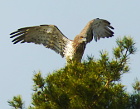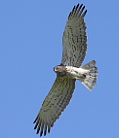The 4th meeting of the Short-toed Snake Eagle French national network is planned to be held: welcome to the Cathar Country!
The 4th meeting of the network will be hosted by Nature Midi-Pyrénées and LPO Mission Rapaces in Roquefixade (the Ariège Department) /map/ on October 8th & 9th, 2016.
The sessions will be held in the town hall where the Eagle Owl meeting was held in 2014. Detailed information about food and accommodation of the participants will be available soon in the next announcement and the registration form.
As usual, the presentations cover various topics: general monitoring of Short-toed Eagle in various regions by local groups, various fields of biology or ecoethology, protection and conservation of the species… All your works are of interest and deserve to be better known.
The presentations should take not more than 20 minutes to allow 10 minutes discussion after each of them. Proposals of your speeches are expected from now on.
To be accepted, your submission must be sent in the form of a summary to one of us (emails below) by July 30th in order to set the agenda for the two days of the meeting.
A registration brochure will be available very soon. Thanks in advance for retaining the date in your fall calendar!
View the original message please: Read the rest of this entry »






